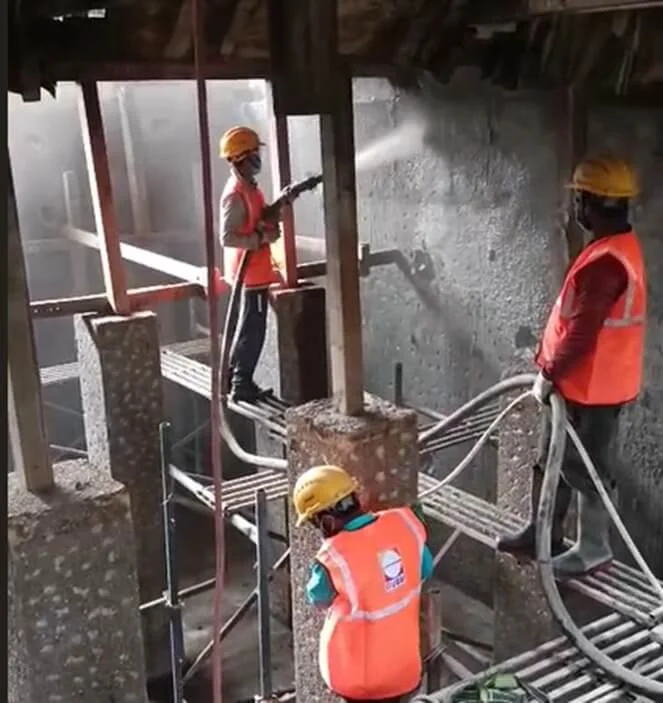Concrete structures, over time, begin to show signs of wear and deterioration due to factors like weathering, corrosion, and structural stress. This is where Guniting emerges as one of the most reliable and effective repair methods. It provides a long-lasting solution to restore the strength and durability of damaged concrete surfaces, ensuring extended structural life and safety for buildings, bridges, and industrial structures.
What is Guniting?
Guniting, also known as dry-mix shotcreting, is a technique used to repair or strengthen concrete structures. It involves spraying a dry mixture of cement and sand through a nozzle at high velocity using compressed air. Water is added just before application, allowing the concrete mix to bond tightly with the surface. This method ensures dense, uniform, and strong layers that adhere firmly to the substrate.
Why Guniting is Preferred Over Traditional Concrete Repair Methods
One of the biggest advantages of Guniting is its ability to create a seamless and compact surface that minimizes voids and cracks. Unlike conventional concrete repair techniques, it doesn’t require formwork and can be applied vertically or overhead. This flexibility makes it suitable for repairing bridges, tunnels, retaining walls, and water tanks where traditional concreting may be difficult or impractical.
The Process of Guniting in Construction and Repair
The Guniting process involves several well-defined steps. First, the surface is cleaned thoroughly to remove dust, grease, or loose particles. Then, the dry mix is prepared using high-quality cement and sand. The mixture is pushed through a hose using compressed air, and water is injected at the nozzle. The resulting spray coats the surface with a dense, durable layer of mortar that restores both strength and surface integrity.
Applications of Guniting in Structural Repair
Guniting services are widely used in various types of construction and repair projects. It plays a vital role in RCC strengthening, slope stabilization, tunnel lining, water tank rehabilitation, and repairing marine or coastal structures. The technique is also applied in retrofitting old bridges, dams, and industrial chimneys. Due to its versatility, it has become a preferred method among shotcreting contractors across India.
Guniting in Building Rehabilitation
As buildings age, their concrete components often weaken due to corrosion of reinforcement and moisture penetration. In such cases, Guniting provides an economical and time-efficient repair option. The process can restore structural elements like columns, beams, and slabs without full demolition. The high adhesion of the gunite mix ensures that the new surface bonds strongly with the old concrete, giving a rejuvenated appearance and enhanced strength.
Guniting vs Shotcreting: Understanding the Difference
Although both terms are often used interchangeably, Guniting and Shotcreting differ slightly in their application method. Guniting is a dry-mix process, while shotcreting usually refers to a wet-mix process. In Guniting, water is added at the nozzle, allowing greater control of the mix during spraying. This makes it more suitable for repair works and areas where precise control and minimal rebound are essential.
Advantages of Using Guniting in Construction Projects
There are numerous benefits associated with Guniting. It produces a high-density concrete layer with superior bonding strength and reduced permeability. The absence of formwork cuts down project costs and labor requirements. Moreover, the process allows application on vertical and curved surfaces, making it ideal for tanks, domes, and tunnels. The resulting surface is resistant to cracking, weathering, and chemical attack, ensuring long-term performance.
Common Uses of Guniting in Infrastructure Projects
Infrastructure projects often rely on Guniting for protection and maintenance. It is widely used in bridge repair, tunnel rehabilitation, and slope stabilization. Engineers also apply gunite coatings to dams, spillways, and retaining walls to prevent seepage and erosion. In urban areas, it serves as an effective solution for basement waterproofing and structural rehabilitation, extending the service life of both new and old structures.
Materials Used in Guniting
The quality of Guniting largely depends on the materials used. The mix generally consists of Portland cement and well-graded fine sand in a specific ratio. Additives such as accelerators and waterproofing compounds are often included to enhance performance. Clean, potable water is used for hydration at the nozzle. The strength and bonding capacity of gunite depend on the quality control maintained during material selection and mixing.
Guniting for RCC Strengthening and Retrofitting
In the field of RCC strengthening, Guniting has proven to be a valuable method. It reinforces weakened sections of concrete structures without the need for complete dismantling. Engineers often use it along with steel mesh or fiber reinforcement to increase load-bearing capacity. For retrofitting, it provides a durable, uniform layer that improves the structure’s resilience against dynamic and seismic forces while restoring its functional integrity.
Guniting for Slope Protection and Erosion Control
In hilly terrains and infrastructure projects, Guniting is often applied for slope protection and erosion control. The sprayed concrete forms a strong protective cover over loose soil or rock, preventing landslides and surface erosion. This method is particularly beneficial for highway embankments, railway cuttings, and hill stabilization works. It ensures long-term stability while blending seamlessly with natural surroundings after landscaping.
Guniting in Water Retaining Structures
Water-retaining structures such as swimming pools, tanks, and reservoirs require watertight and crack-free surfaces. Guniting offers excellent waterproofing capability, making it the go-to technique for repairing and lining such structures. The dense, impermeable layer produced by the process prevents water seepage and ensures longevity. It is also resistant to chemical reactions caused by chlorinated or contaminated water, enhancing the durability of storage systems.
Choosing the Right Guniting Contractors
Selecting experienced Guniting contractors is crucial for achieving reliable and durable outcomes. Skilled professionals ensure proper mix design, nozzle control, and surface preparation. They use advanced equipment to maintain uniform pressure and minimize material wastage. When hiring contractors, always check their experience in concrete repair, shotcreting, and structural rehabilitation projects. Quality workmanship significantly impacts the long-term performance of the repaired surface.
Maintenance After Guniting Application
Post-application maintenance plays a vital role in the performance of Guniting work. Proper curing ensures that the surface achieves maximum strength and durability. Typically, the guniting area should be kept moist for several days to prevent shrinkage cracks. Regular inspections help detect early signs of wear or damage, allowing timely maintenance. With correct application and upkeep, gunited structures can remain strong and reliable for decades.
With the rising demand for sustainable and efficient repair methods, Guniting stands out as a preferred choice for engineers and contractors alike. Its speed, cost-efficiency, and versatility make it ideal for both small and large-scale structural repairs. Whether for RCC strengthening, tunnel lining, or waterproofing, Guniting delivers lasting results. For any aging or damaged concrete surface, this technique ensures renewed strength, safety, and structural integrity.


